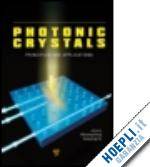
Questo prodotto usufruisce delle SPEDIZIONI GRATIS
selezionando l'opzione Corriere Veloce in fase di ordine.
Pagabile anche con Carta della cultura giovani e del merito, 18App Bonus Cultura e Carta del Docente
This book provides a broad overview of photonic crystals and, as the title suggests, covers their principles and applications. It is written from a physics point of view with an emphasis on materials science. Equations are well explained and often completely avoided to increase the readability of the book.
The book is divided into eight chapters, starting with a brief introduction. The second chapter deals with different dimensionalities of the photonic crystals and their properties. The third chapter is very interestingly written and provides a survey of the various synthesis methods used for production of photonic crystals, including chemical routes, lithography, and self-assembly of colloidal photonic crystals. Chapters 4–8 constitute the bulk of the book and provide examples of applications of these photonic crystals.
Chapter 4 offers a good explanation of optical switching. Bandgap and defect mode switching are also brought into focus along with many other mechanisms—14 different switching mechanisms in all, including thermal, electro, and magneto switching. Frequency tuning of photonic crystal filters with special attention to nanosize photonic crystals is illustrated, providing a direct perspective on applications of these materials in integrated photonic circuits. The transition from chapter 5 to 6 dealing with photonic crystal lasers is smooth, especially after a clear description of frequency tuning. Here, one- to three-dimensional photonic lasers are explained along with laser oscillations produced by a variety of microcavity methods. Metallodielectric and liquid-crystal photonic lasers are equally well illustrated. Chapter 7 introduces logic devices based on photonic crystals. This chapter clearly explains, with the help of simple illustrations, how to obtain AND, OR, and XOR logic gates. Chapter 8 concludes the book by presenting possible applications, including gas, chemical, fluid, and cell sensing; their workings are very well described from a fundamental point of view.
The diagrams and illustrations are appropriate and eye catching. There are ample references; thus readers are able to find more detailed information to satisfy their curiosity if the book does not suffice. Even though the introduction provides basics of these photonic crystals, I do get the impression that the bigger picture is missing. A nonexpert may not understand the direct application of such materials right from the beginning of the book. A flowchart or a diagram of these photonic crystals, illustrating applications in daily life at the beginning of the book, could attract a broader readership. In this regard, I believe that this book is most adapted to physicists with a materials science background or vice versa. However, one should take into consideration that the principles of photonic crystals cannot be explained without physics, and therefore the quality of this book remains intact and could very well serve as a textbook for future physicists.
Introduction
Primary Properties of Photonic Crystals
Fabrication of Photonic Crystals
Photonic Crystal All-Optical Switching
Tunable Photonic Crystal Filter
Photonic Crystal Laser
Photonic Crystal Logic Devices
Photonic Crystal Sensors
Qihuang Gong received his BSc and PhD, both in physics, from Peking University, China, in 1983 and 1989, respectively. He is the Cheung Kong Scholar of Peking University, director of State Key Laboratory for Artificial Microstructure and Mesoscopic Physics, vice dean of the Department of Physics, chief scientist of National 973 Project, and group leader of the Creative research group of the National Natural Science Foundation of China. His current research interests are ultrafast optics and spectroscopy, nonlinear optics, and mesoscopic optical devices for applications in optical information processing and communication. He has published more than 300 SCI papers, which have been cited over 2400 times. Winner of several awards, Prof. Gong serves as the topic editor of Optics Letters, advisor editor of Chemical Physics, and associate editor-in-chief of Chinese Physics B, Chinese Optics Letters, Chinese Science Bulletin (in Chinese), Chinese Optics and Applied Optics (in Chinese), Acta Physics Sinica (in Chinese), and Quantum Electronics (in Chinese). He is also an executive council member of the Chinese Optics Society, director of Fundamental Optics Division, and executive council member of the Chinese Physical Society. He has been a member of the IUPAP C17 (Quantum Electronics) Commission, member of the Fellow Committee and the international council of the Optical Society of America (OSA), fellow of the OSA and IoP, and co-chair of the Asian Intense Laser Network.











Il sito utilizza cookie ed altri strumenti di tracciamento che raccolgono informazioni dal dispositivo dell’utente. Oltre ai cookie tecnici ed analitici aggregati, strettamente necessari per il funzionamento di questo sito web, previo consenso dell’utente possono essere installati cookie di profilazione e marketing e cookie dei social media. Cliccando su “Accetto tutti i cookie” saranno attivate tutte le categorie di cookie. Per accettare solo deterninate categorie di cookie, cliccare invece su “Impostazioni cookie”. Chiudendo il banner o continuando a navigare saranno installati solo cookie tecnici. Per maggiori dettagli, consultare la Cookie Policy.